Weighted Iterative CD-Spline for Mitigating Occlusion Effects on Building Boundary Regularization Using Airborne LiDAR Data
Abstract
1. Introduction
2. Proposed Method
2.1. Critical Point Determination
2.2. CD-Spline Modeling and Weight Function
2.3. Residual Determination for Boundary Points in Occluded Regions
3. Experiment Design and Quality Assessment
4. Results
4.1. Simulated Data
4.2. Real Data
5. Discussion
6. Conclusions
Author Contributions
Funding
Informed Consent Statement
Acknowledgments
Conflicts of Interest
References
- dos Santos, R.C.; Galo, M.; Habib, A.F. Regularization of Building Roof Boundaries from Airborne LiDAR Data Using an Iterative CD-Spline. Remote Sens. 2020, 12, 1904. [Google Scholar] [CrossRef]
- Feng, M.; Zhang, T.; Li, S.; Jin, G.; Xia, Y. An Improved Minimum Bounding Rectangle Algorithm for Regularized Building Boundary Extraction from Aerial LiDAR Point Clouds with Partial Occlusions. Int. J. Remote Sens. 2020, 41, 300–319. [Google Scholar] [CrossRef]
- Maas, H.-G.; Vosselman, G. Two Algorithms for Extracting Building Models from Raw Laser Altimetry Data. ISPRS J. Photogramm. Remote Sens. 1999, 54, 153–163. [Google Scholar] [CrossRef]
- Xu, J.; Wan, Y.; Yao, F. A Method of 3D Building Boundary Extraction from Airborne LIDAR Points Cloud. In Proceedings of the 2010 Symposium on Photonics and Optoelectronics, Chengdu, China, 19–21 June 2010; IEEE: Chengdu, China, 2010; pp. 1–4. [Google Scholar]
- Awrangjeb, M. Using Point Cloud Data to Identify, Trace, and Regularize the Outlines of Buildings. Int. J. Remote Sens. 2016, 37, 551–579. [Google Scholar] [CrossRef]
- Satari, M.; Samadzadegan, F.; Azizi, A.; Maas, H.-G. A Multi-Resolution Hybrid Approach for Building Model Reconstruction from Lidar Data: A Multi-Resolution Hybrid Approach for Building Model Reconstruction. Photogramm. Rec. 2012, 27, 330–359. [Google Scholar] [CrossRef]
- Albers, B.; Kada, M.; Wichmann, A. Automatic Extraction and Regularization of Building Outlines from Airborne Lidar Point Clouds. Int. Arch. Photogramm. Remote Sens. Spatial Inf. Sci. 2016, XLI-B3, 555–560. [Google Scholar] [CrossRef]
- Ozdemir, E.; Karsli, F.; Kavzoglu, T.; Bahadir, M.; Yagmahan, A. A Novel Algorithm for Regularization of Building Footprints Using Raw LiDAR Point Clouds. Geocarto Int. 2021, 1–23. [Google Scholar] [CrossRef]
- Gilani, S.; Awrangjeb, M.; Lu, G. An Automatic Building Extraction and Regularisation Technique Using LiDAR Point Cloud Data and Orthoimage. Remote Sens. 2016, 8, 258. [Google Scholar] [CrossRef]
- Awrangjeb, M.; Lu, G. Automatic Building Footprint Extraction and Regularisation from LIDAR Point Cloud Data. In Proceedings of the 2014 International Conference on Digital Image Computing: Techniques and Applications (DICTA), Wollongong, NSW, Australia, 25–27 November 2014; IEEE: Wollongong, NSW, Australia, 2014; pp. 1–8. [Google Scholar]
- Dorninger, P.; Pfeifer, N. A Comprehensive Automated 3D Approach for Building Extraction, Reconstruction, and Regularization from Airborne Laser Scanning Point Clouds. Sensors 2008, 8, 7323–7343. [Google Scholar] [CrossRef] [PubMed]
- Jung, J.; Jwa, Y.; Sohn, G. Implicit Regularization for Reconstructing 3D Building Rooftop Models Using Airborne LiDAR Data. Sensors 2017, 17, 621. [Google Scholar] [CrossRef] [PubMed]
- Kwak, E.; Habib, A. Automatic Representation and Reconstruction of DBM from LiDAR Data Using Recursive Minimum Bounding Rectangle. ISPRS J. Photogramm. Remote Sens. 2014, 93, 171–191. [Google Scholar] [CrossRef]
- Lee, J. Extraction and Regularization of Various Building Boundaries with Complex Shapes Utilizing Distribution Characteristics of Airborne LIDAR Points. ETRI J. 2011, 33, 547–557. [Google Scholar] [CrossRef]
- dos Santos, R.C.; Galo, M.; Carrilho, A.C. Extraction of Building Roof Boundaries from LiDAR Data Using an Adaptive Alpha-Shape Algorithm. IEEE Geosci. Remote Sens. Lett. 2019, 16, 1289–1293. [Google Scholar] [CrossRef]
- Shen, W.; Wang, G. Changeable Degree Spline Basis Functions. J. Comput. Appl. Math. 2010, 234, 2516–2529. [Google Scholar] [CrossRef][Green Version]
- Bartels, R.H.; Beatty, J.C.; Barsky, B.A. An Introduction to Splines for Use in Computer Graphics and Geometric Modeling; Morgan Kaufmann: Burlington, MA, USA, 1995. [Google Scholar]
- Mood, A.M.F.; Graybill, F.A.; Boes, D.C. Introduction to the Theory of Statistics; McGraw-Hill international editions: Statistics series; McGraw-Hill: New York, NY, USA, 1974; ISBN 978-0-07-085465-9. [Google Scholar]
- Lindgren, B.W. Statistical Theory; Collier Macmillan international editions; Macmillan: New York, NY, USA, 1976; ISBN 978-0-07-085465-9. [Google Scholar]
- Tommaselli, A.M.G.; Galo, M.; dos Reis, T.T.; da Silva Ruy, R.; de Moraes, M.V.A.; Matricardi, W.V. Development and Assessment of a Data Set Containing Frame Images and Dense Airborne Laser Scanning Point Clouds. IEEE Geosci. Remote Sens. Lett. 2018, 15, 192–196. [Google Scholar] [CrossRef]
- Wiedemann, C.; Heipke, C.; Mayer, H.; Jamet, O. Empirical Evaluation of Automatically Extracted Road Axes. Empir. Eval. Tech. Comput. Vis. 1998, 12, 172–187. [Google Scholar]
- Sokolova, M.; Japkowicz, N.; Szpakowicz, S. Beyond Accuracy, F-Score and ROC: A Family of Discriminant Measures for Performance Evaluation. In AI 2006: Advances in Artificial Intelligence; Sattar, A., Kang, B., Nierstrasz, O., Kanade, T., Kittler, J., Kleinberg, J.M., Mattern, F., Mitchell, J.C., Naor, M., Hutchison, D., et al., Eds.; Springer: Berlin/Heidelberg, Germany, 2006; Volume 4304, pp. 1015–1021. ISBN 978-3-540-49787-5. [Google Scholar]
- Avbelj, J.; Muller, R.; Bamler, R. A Metric for Polygon Comparison and Building Extraction Evaluation. IEEE Geosci. Remote Sens. Lett. 2015, 12, 170–174. [Google Scholar] [CrossRef]
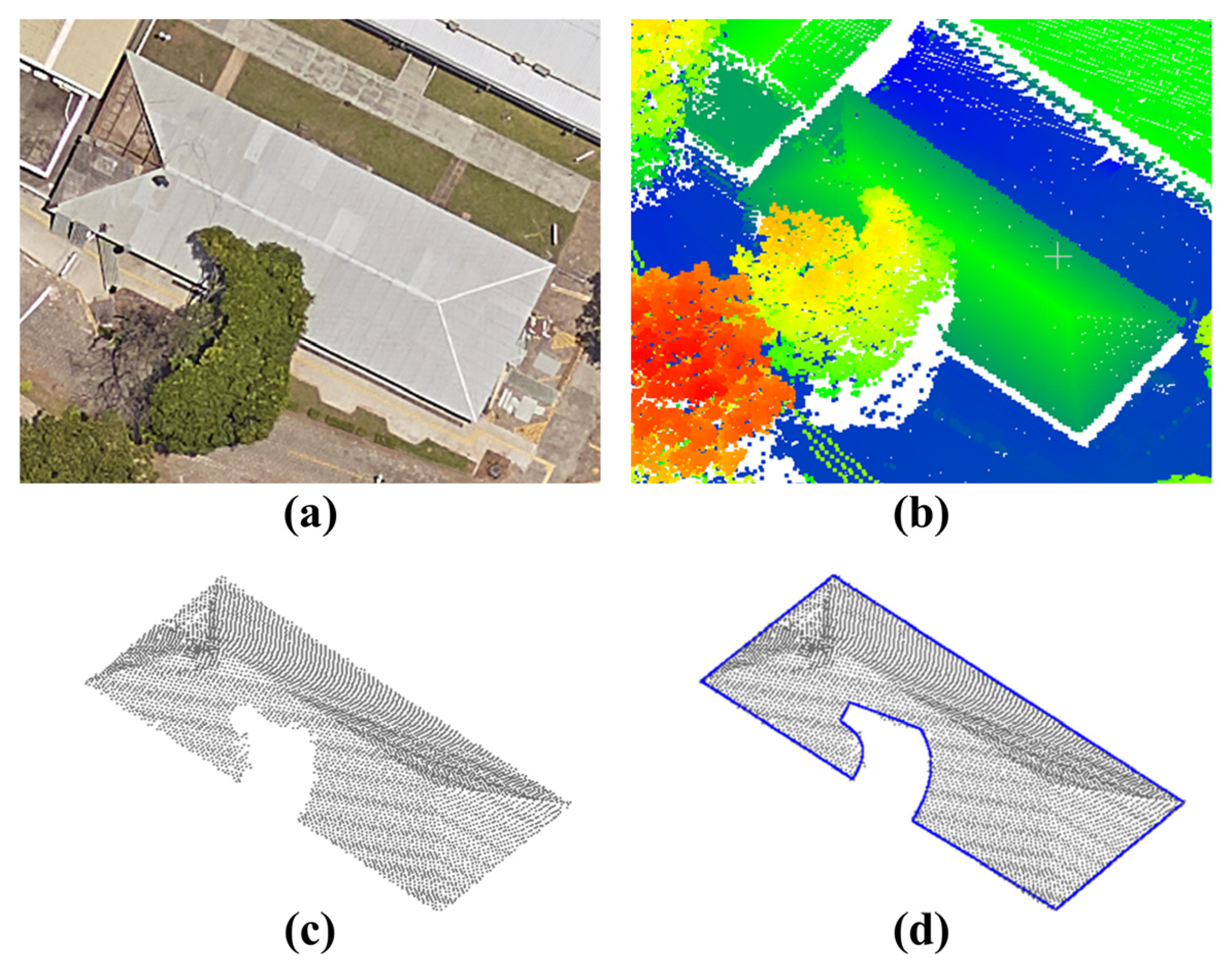

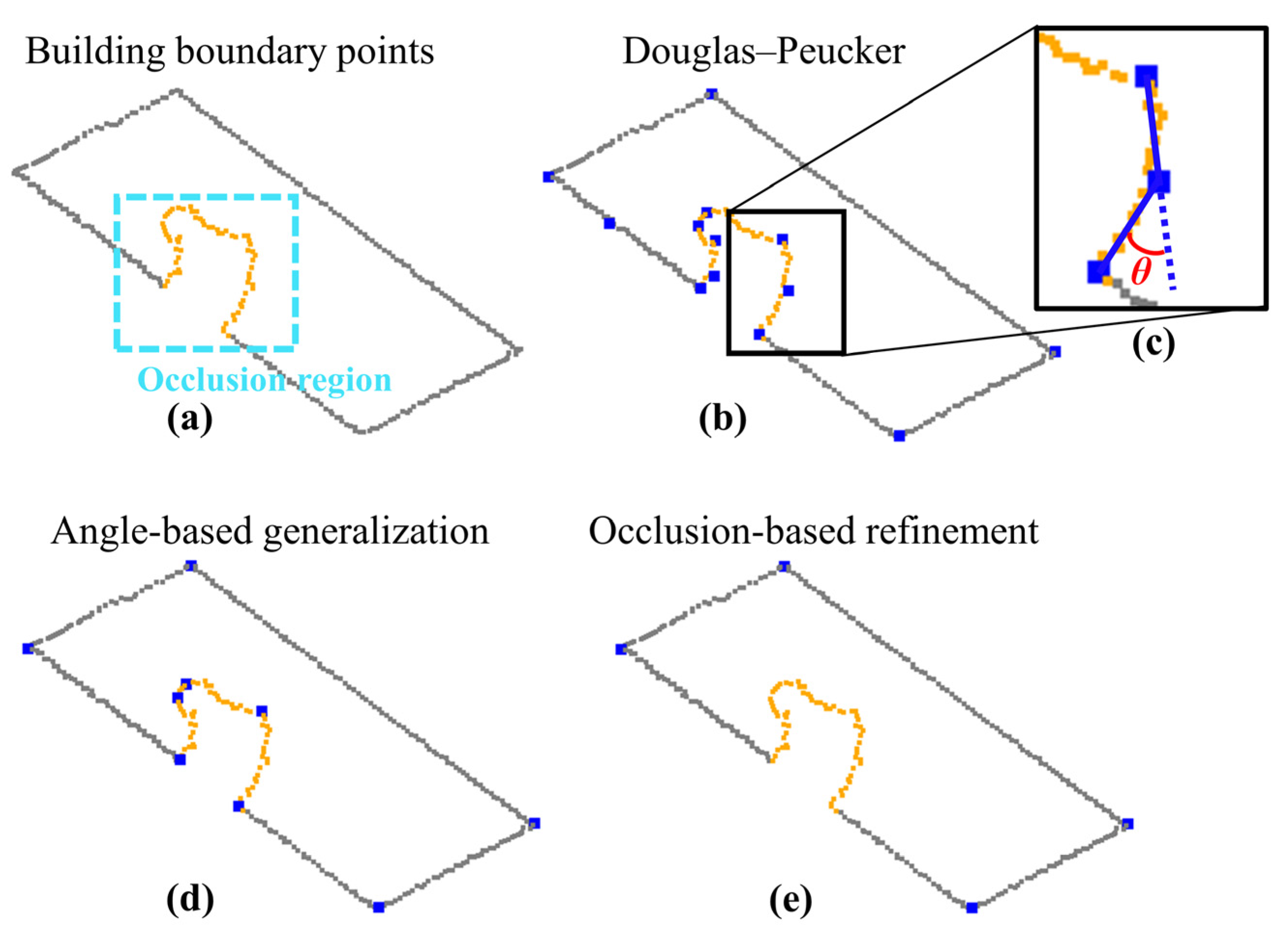
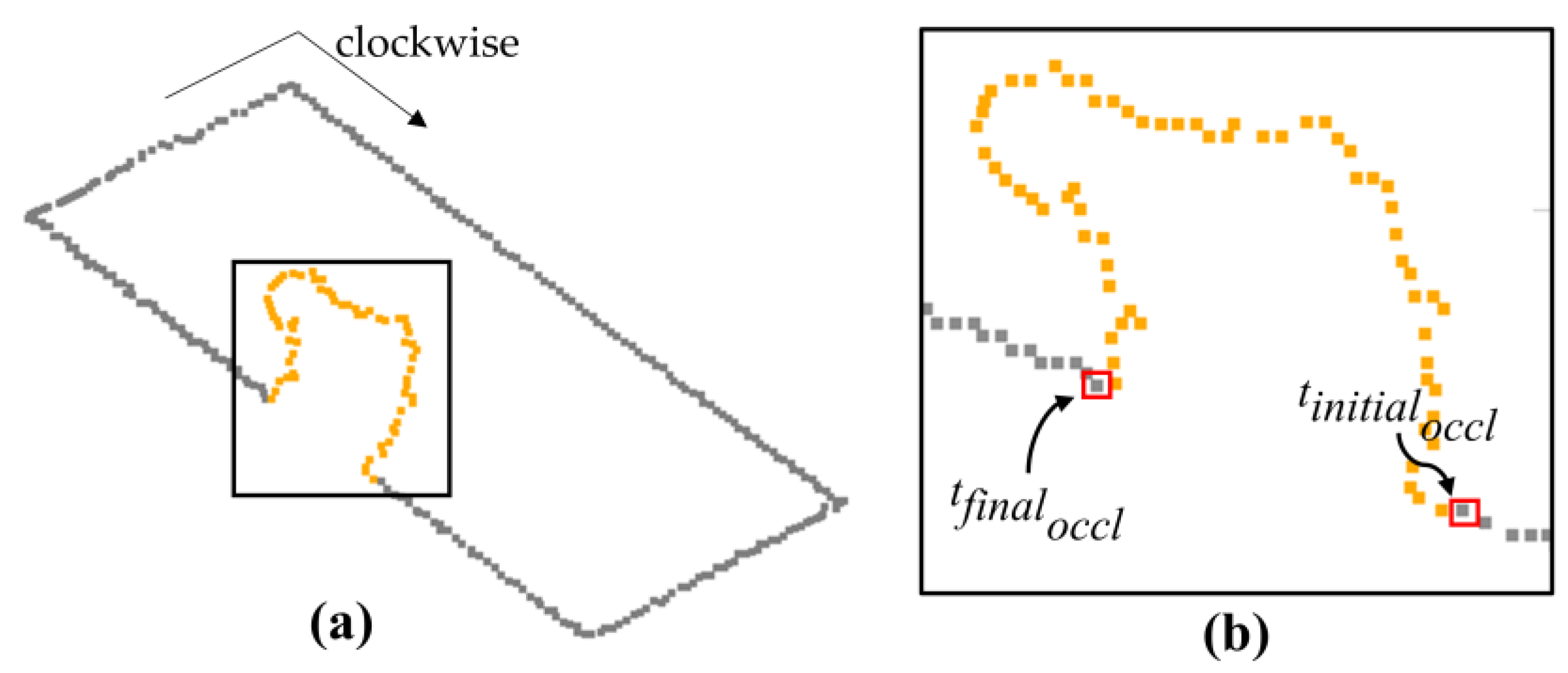

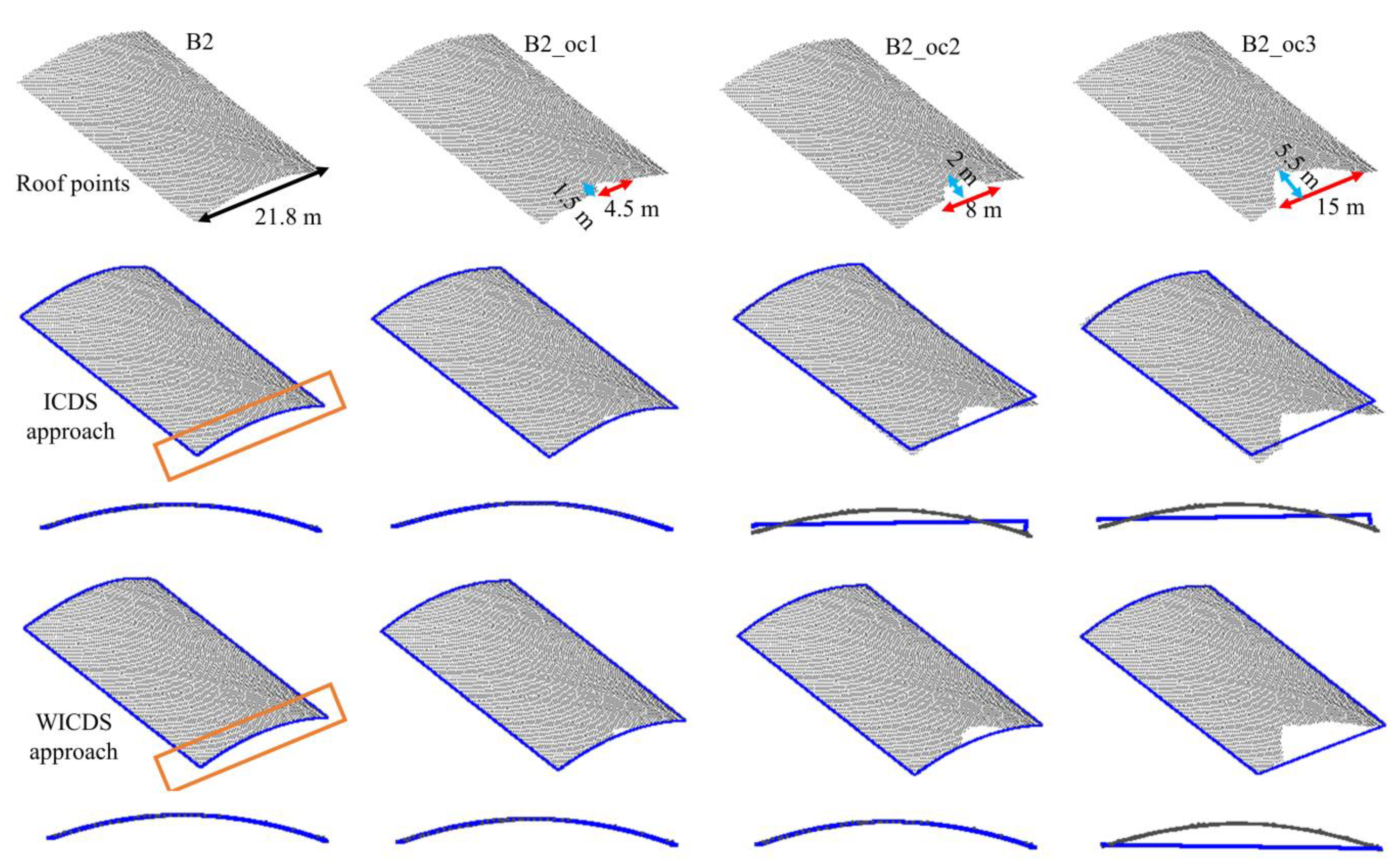
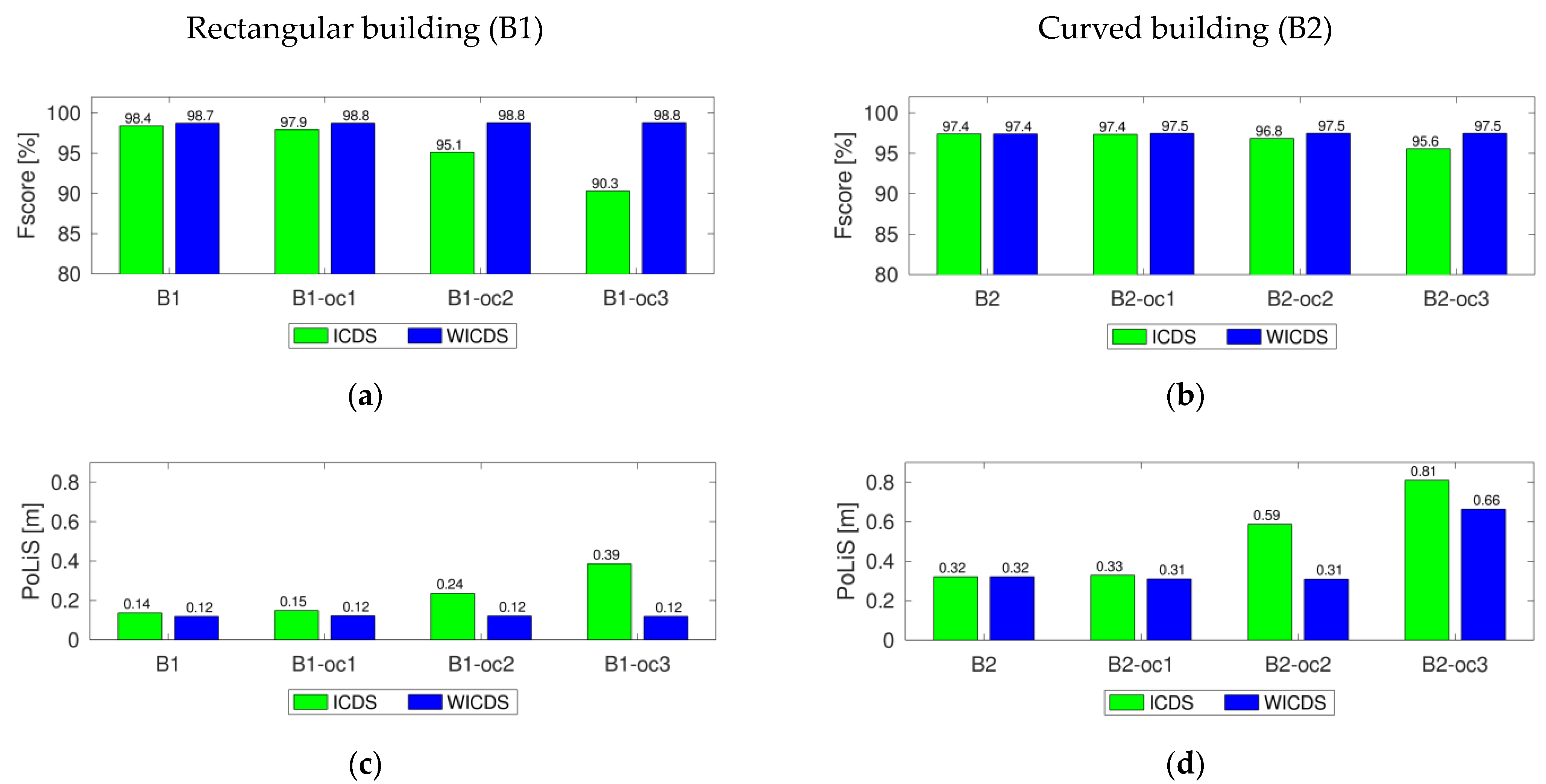
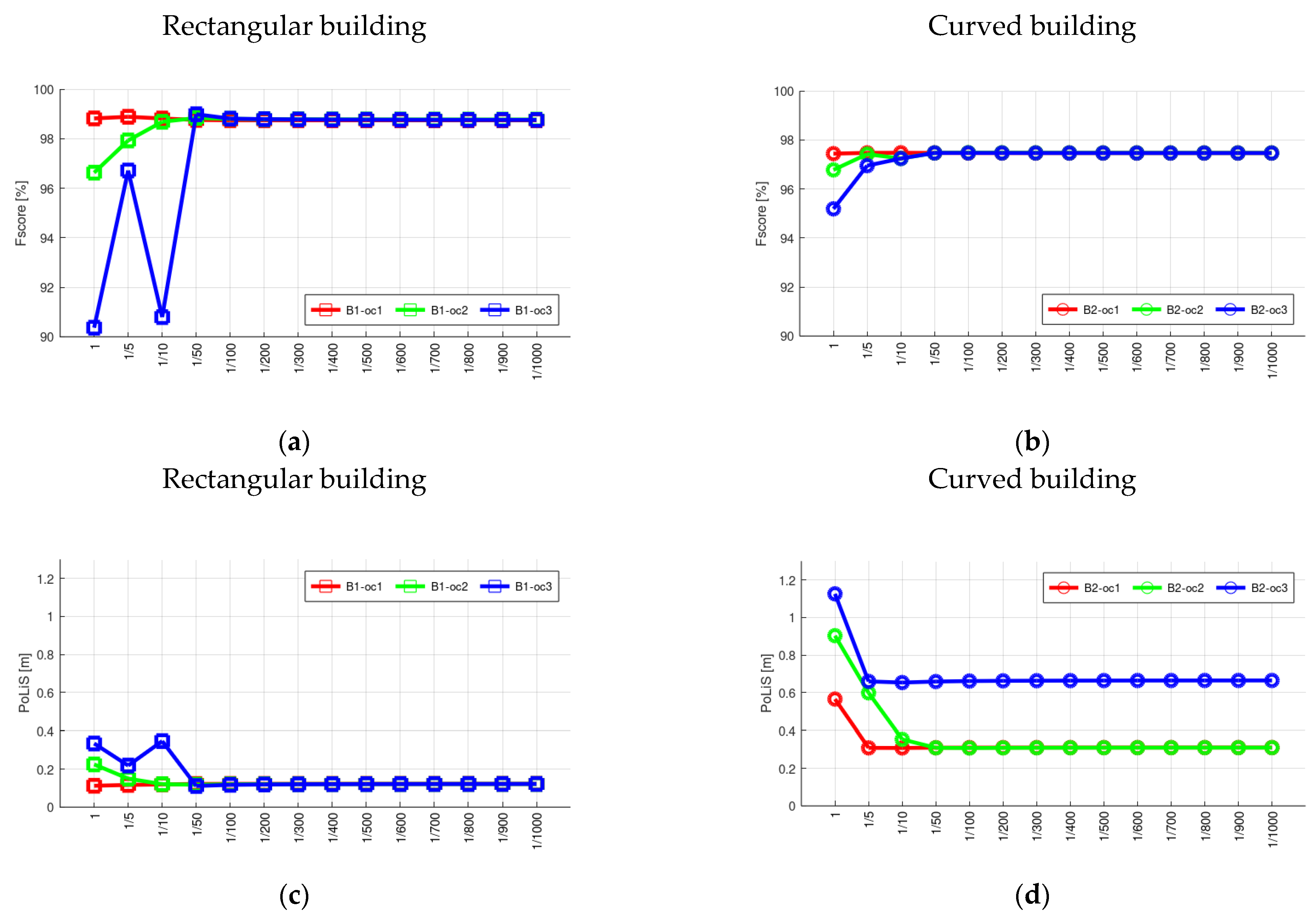

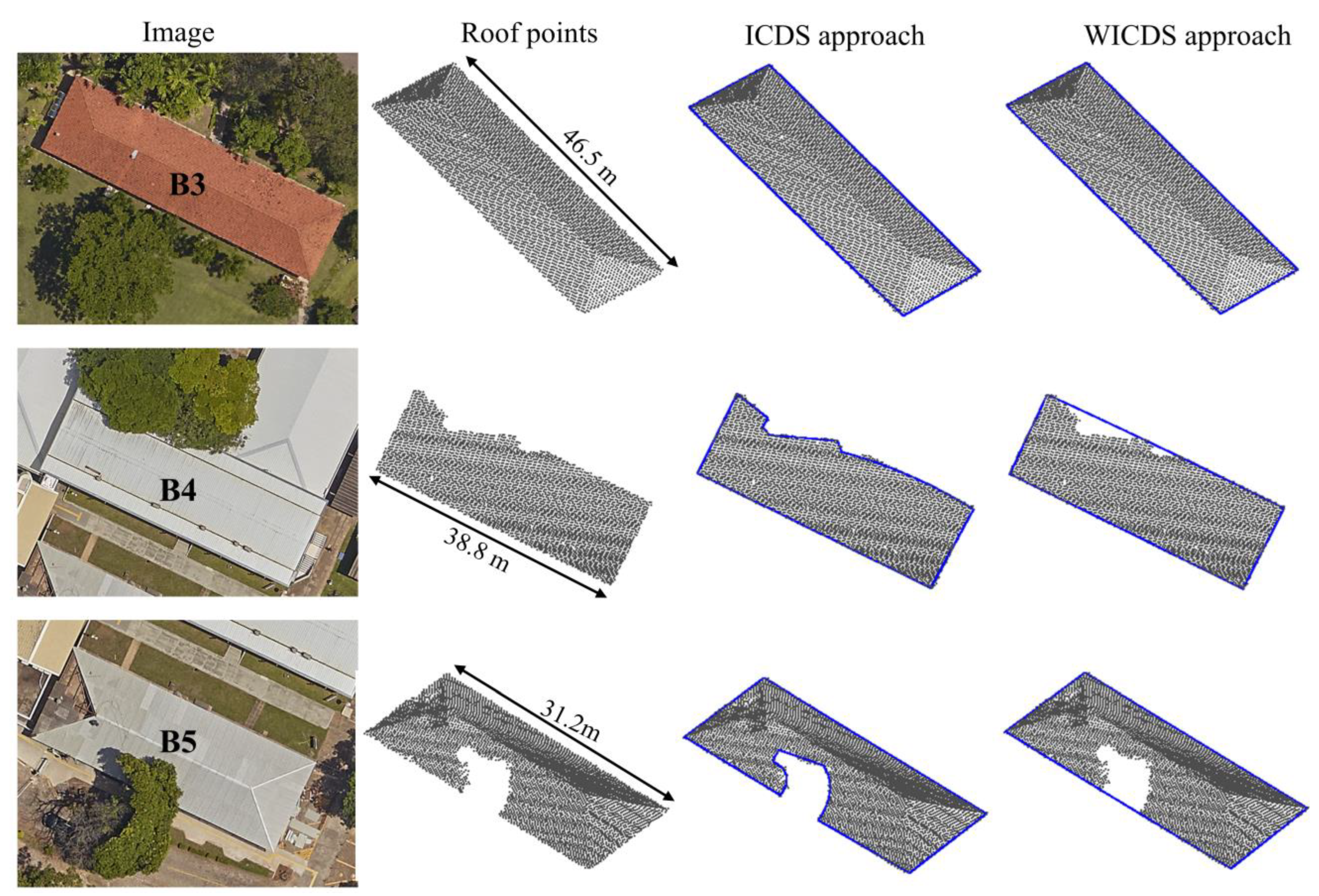

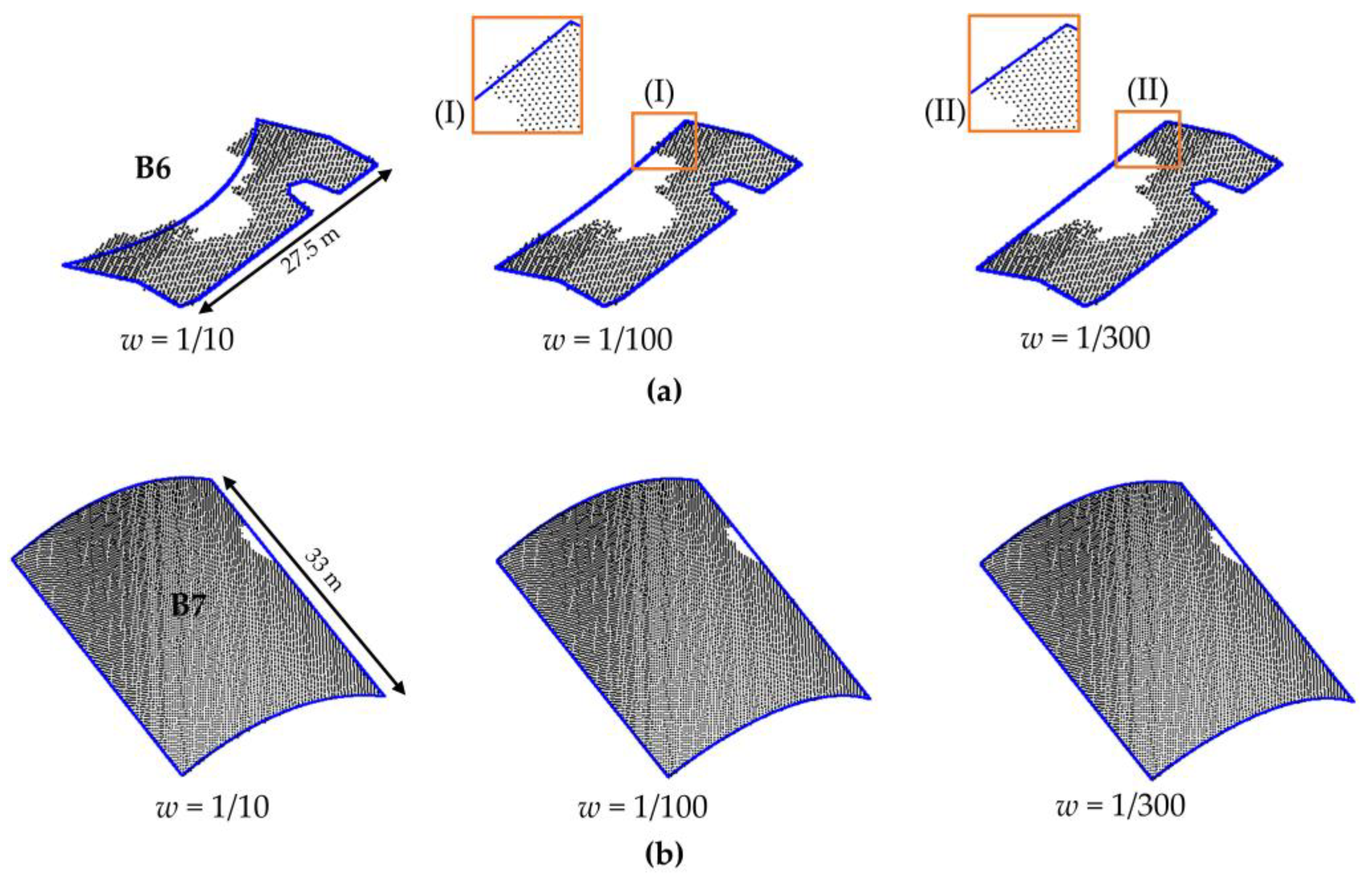
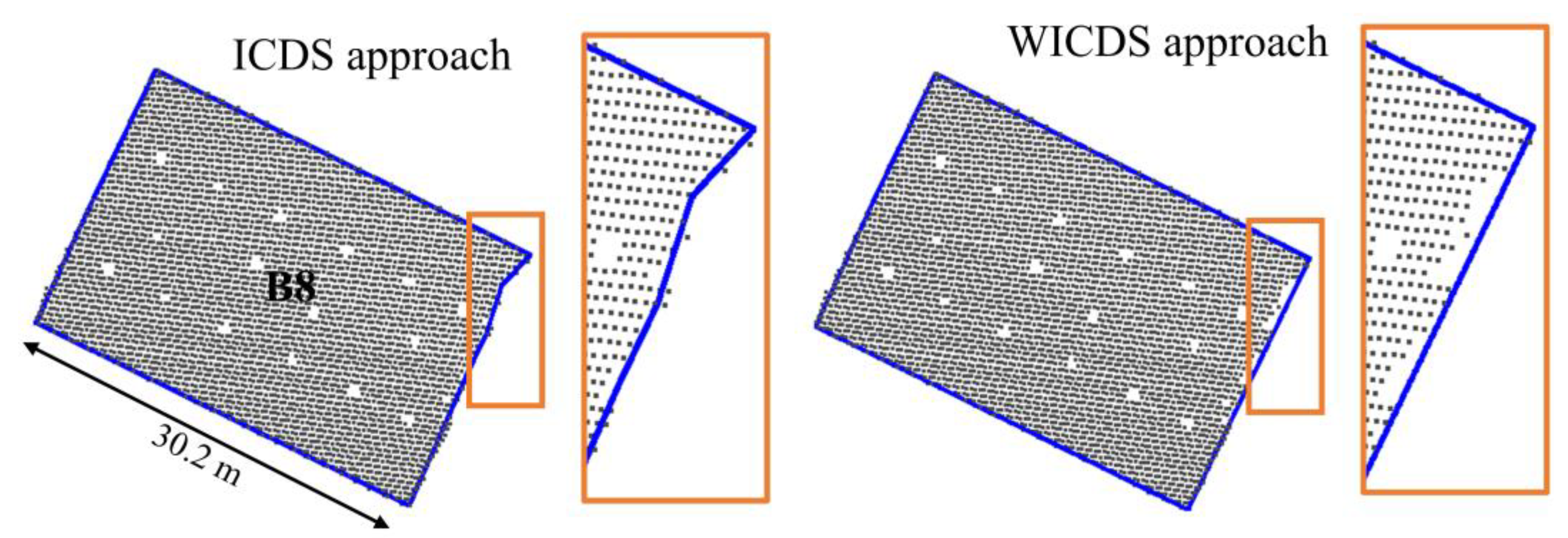



| Reference | ICDS Approach | WICDS Approach | |||
|---|---|---|---|---|---|
| ID | Area (m2) | Area (m2) | ER (%) | Area (m2) | ER (%) |
| B3 | 595.72 | 584.24 | −1.93 | 584.90 | −1.82 |
| B4 | 454.03 | 422.09 | −7.03 | 444.76 | −2.04 |
| B5 | 383.05 | 349.42 | −8.78 | 376.54 | −1.70 |
| B6 | 303.75 | 210.03 | −30.85 | 290.91 | −4.23 |
| B7 | 805.95 | 801.49 | −0.55 | 811.37 | 0.67 |
| B8 | 612.09 | 601.90 | −1.66 | 608.55 | −0.58 |
| B9 | 52.91 | 44.01 | −16.82 | 51.76 | −2.17 |
| B10 | 108.84 | 106.80 | −1.87 | 109.67 | 0.76 |
| B11 | 77.00 | 75.32 | −2.18 | 75.64 | −1.77 |
| ICDS Approach | WICDS Approach | |||||||
|---|---|---|---|---|---|---|---|---|
| ID | Comp. (%) | Corr. (%) | Fscore (%) | PoLiS (m) | Comp. (%) | Corr. (%) | Fscore (%) | PoLiS (m) |
| B3 | 97.4 | 99.3 | 98.3 | 0.159 | 97.4 | 99.2 | 98.3 | 0.162 (1.88%) * |
| B4 | 92.4 | 99.5 | 95.8 | 0.377 | 97.5 | 99.5 | 98.5 | 0.193 (−48.80%) |
| B5 | 91.0 | 99.8 | 95.2 | 0.434 | 98.1 | 99.8 | 99.0 | 0.121 (−72.12%) |
| B6 | 68.2 | 98.7 | 80.7 | 0.783 | 94.9 | 99.0 | 96.9 | 0.244 (−68.84%) |
| B7 | 98.3 | 98.9 | 98.6 | 1.368 | 99.7 | 99.0 | 99.4 | 0.105 (−92.32%) |
| B8 | 98.2 | 99.8 | 99.0 | 0.294 | 99.2 | 99.8 | 99.5 | 0.561 (90.82%) |
| B9 | 82.1 | 98.7 | 89.7 | 0.274 | 96.6 | 98.8 | 97.7 | 0.147 (−46.35%) |
| B10 | 97.1 | 99.0 | 98.1 | 0.109 | 99.3 | 98.6 | 98.9 | 0.084 (−22.94%) |
| B11 | 96.7 | 98.9 | 97.8 | 0.107 | 97.1 | 98.8 | 97.9 | 0.104 (−2.8%) |
| Mean | 91.3 | 99.2 | 94.8 | 0.434 | 97.8 | 99.2 | 98.5 | 0.191 (−55.93%) |
Publisher’s Note: MDPI stays neutral with regard to jurisdictional claims in published maps and institutional affiliations. |
© 2022 by the authors. Licensee MDPI, Basel, Switzerland. This article is an open access article distributed under the terms and conditions of the Creative Commons Attribution (CC BY) license (https://creativecommons.org/licenses/by/4.0/).
Share and Cite
dos Santos, R.C.; Habib, A.F.; Galo, M. Weighted Iterative CD-Spline for Mitigating Occlusion Effects on Building Boundary Regularization Using Airborne LiDAR Data. Sensors 2022, 22, 6440. https://doi.org/10.3390/s22176440
dos Santos RC, Habib AF, Galo M. Weighted Iterative CD-Spline for Mitigating Occlusion Effects on Building Boundary Regularization Using Airborne LiDAR Data. Sensors. 2022; 22(17):6440. https://doi.org/10.3390/s22176440
Chicago/Turabian Styledos Santos, Renato César, Ayman F. Habib, and Mauricio Galo. 2022. "Weighted Iterative CD-Spline for Mitigating Occlusion Effects on Building Boundary Regularization Using Airborne LiDAR Data" Sensors 22, no. 17: 6440. https://doi.org/10.3390/s22176440
APA Styledos Santos, R. C., Habib, A. F., & Galo, M. (2022). Weighted Iterative CD-Spline for Mitigating Occlusion Effects on Building Boundary Regularization Using Airborne LiDAR Data. Sensors, 22(17), 6440. https://doi.org/10.3390/s22176440







